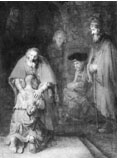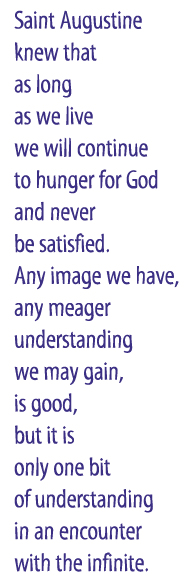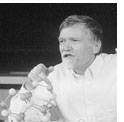
By
Carl Helrich, professor of physics
There are certain images that stir our imaginations. The African-American poet,
Weldon Johnson, gave us one of the creation when he wrote, “God stepped
out on space and said, ‘I’m lonely. I’ll make me a world.’”
We do not even want to dispute the concepts of space here; the image is too
beautiful and truly gripping. And regardless of how we may want to interpret
these words, that is what God did and is doing.
 If
we look at Rembrandt van Rijn’s painting of the return of the prodigal
son, we see the creation again. This time it is the creation of new life within
one human being, who has been lost. Rembrandt doesn’t depict the scene
in glory and amid flashes of light from stars and supernovae, but in the quiet
touch of a father’s hands upon a kneeling boy.
If
we look at Rembrandt van Rijn’s painting of the return of the prodigal
son, we see the creation again. This time it is the creation of new life within
one human being, who has been lost. Rembrandt doesn’t depict the scene
in glory and amid flashes of light from stars and supernovae, but in the quiet
touch of a father’s hands upon a kneeling boy.
The image of God’s making of a new world
is there, even if the portrayal is slightly different.
Neither Rembrandt’s painting nor Johnson’s
words gives us the complete truth nor touches every part of us. Even taken together,
these two cannot speak the totality of God’s truth to us. We are too complex
as human beings and God is infinite mystery.
Saint Augustine
knew that as long as we live we will continue to hunger for God and never be
satisfied. Any image we have, any meager understanding we may gain, is good,
but it is only one bit of understanding in an encounter with the Infinite.
Astrophysicist Subrahmanyan Chandrasekhar
has described physics as motivated by a search for truth and beauty, since we
believe in beauty much more than we ever believe in demonstrable truth. Lord
 Byron
told us that truth and beauty are the same, which Chandrasekhar also affirms.
But Chandra’s quest is to uncover that beauty and to find that truth in
the form of the creation. Any pursuit of truth, is, in its essence, a pursuit
of God, and the Holy Spirit is the source of that truth.
Byron
told us that truth and beauty are the same, which Chandrasekhar also affirms.
But Chandra’s quest is to uncover that beauty and to find that truth in
the form of the creation. Any pursuit of truth, is, in its essence, a pursuit
of God, and the Holy Spirit is the source of that truth.
As Albert Einstein once said, “I want
to know God’s thoughts, the rest is details.”
We do understand some of the details –
as poets, as artists, as musicians and even as scientists. We catch glimpses
of those thoughts in the world’s details. But we do not know the thoughts
of God.
As Paul Tillich said, God is infinite mystery.
God is not something to be understood or a problem to be solved. And there is
a huge area that we do not understand. All we can expect to do, then, is to
reveal the problem itself and, perhaps, to appreciate, from our perspective
as human beings, what is involved when we brush against the Infinite.
What does it mean for God to interact with
us? What do we encounter when we encounter God?
Truly, the search for truth and beauty is
probably more important than the outcomes. Goshen College’s “Science
and Religion” theme is a wonderful invitation to explore God’s thoughts
in avenues which will be new – regardless of where we stand.
Theologically, we predicate our operations
on faith with limited measurements. Scientifically, we must recognize that what
we can know is limited by what we can measure. Of course, there is some competition
within our minds about the intersection of these two subjects that sometimes
seem to contradict, but if we have a division, neither human beings nor the
church can benefit.
And while scientists should not pretend to
have knowledge beyond what can be measured, we still believe in beauty.
As a professor and a scientist, I realize
full well that such studies often only leave small impressions, and even the
great impressions often are not realized until many years later. But, as a human
being who has been exploring these things for some time, I can appreciate the
type of opportunity for discussion and debate that exists on campus.
As young engineering students, my friends
and I used to have discussions of  God
and the universe late Friday or Saturday nights when we had time to spend as
we wanted. Our professors did think of truth and beauty, and some even thought
of God. But an institute of technology would not have taken up this theme that
combines such complementary and diverse disciplines.
God
and the universe late Friday or Saturday nights when we had time to spend as
we wanted. Our professors did think of truth and beauty, and some even thought
of God. But an institute of technology would not have taken up this theme that
combines such complementary and diverse disciplines.
At Goshen College, we have the opportunity
to explore the avenues of truth, beauty and thoughts of God in conversations
among and between faculty, students and staff in a concentrated and open fashion.
Such a program helps us expand the dialogue and understand the joy inherent
in the process of searching.
As the theologian Phil Hefner said, such investigations
in religion and science are among the most important things we can be about.
Return to April Bulletin
contents
Science and simplicity by
President Shirley H. Showalter
Traces of God’s handiwork in the universe
by Rachel Lapp
The
best of times, the worst of times by Owen Gingerich ’51
Creating a
community: General education guides discussion by Ryan Miller with Beth
Martin Birky ’83
Science and spirit, hand
in hand by Debra Brubaker ’79
Marrying science and religion, in classroom and
home interview with Elizabeth (Miller) ’51 and Marlin Jeschke
Return to Goshen College home
page

 If
we look at Rembrandt van Rijn’s painting of the return of the prodigal
son, we see the creation again. This time it is the creation of new life within
one human being, who has been lost. Rembrandt doesn’t depict the scene
in glory and amid flashes of light from stars and supernovae, but in the quiet
touch of a father’s hands upon a kneeling boy.
If
we look at Rembrandt van Rijn’s painting of the return of the prodigal
son, we see the creation again. This time it is the creation of new life within
one human being, who has been lost. Rembrandt doesn’t depict the scene
in glory and amid flashes of light from stars and supernovae, but in the quiet
touch of a father’s hands upon a kneeling boy. Byron
told us that truth and beauty are the same, which Chandrasekhar also affirms.
But Chandra’s quest is to uncover that beauty and to find that truth in
the form of the creation. Any pursuit of truth, is, in its essence, a pursuit
of God, and the Holy Spirit is the source of that truth.
Byron
told us that truth and beauty are the same, which Chandrasekhar also affirms.
But Chandra’s quest is to uncover that beauty and to find that truth in
the form of the creation. Any pursuit of truth, is, in its essence, a pursuit
of God, and the Holy Spirit is the source of that truth. God
and the universe late Friday or Saturday nights when we had time to spend as
we wanted. Our professors did think of truth and beauty, and some even thought
of God. But an institute of technology would not have taken up this theme that
combines such complementary and diverse disciplines.
God
and the universe late Friday or Saturday nights when we had time to spend as
we wanted. Our professors did think of truth and beauty, and some even thought
of God. But an institute of technology would not have taken up this theme that
combines such complementary and diverse disciplines.